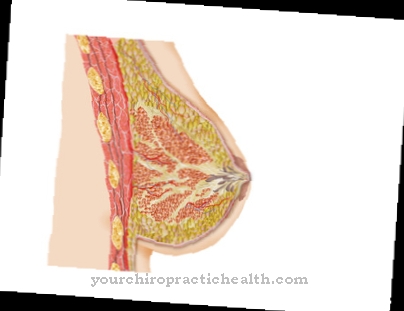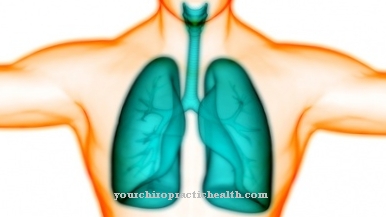The Vital capacity is a parameter of spirometry. It provides information on the lung function when inhaling and exhaling. If the expiratory vital capacity deviates significantly from the inspiratory vital capacity, there is probably a lung disease.
What is the vital capacity

Spirometry measures lung function using a so-called spirometer. The pulmonary function tests determine both parameters for inspiration and values for expiration. That is, they deal with both inhaling and exhaling.
A key factor in all lung function tests is the so-called vital capacity. With reference to inhalation, we speak of the inspiratory vital capacity. The expiratory vital capacity, on the other hand, is the core parameter for lung function during exhalation. Both quantities can be measured with normal breathing or forced breathing. Forced breathing corresponds to breathing at maximum speed. The associated vital capacities are referred to as forced expiratory and forced inspiratory vital capacity.
Other key parameters of the lung function test are the lung volumes. They describe the volume of air that is in the lungs and airways during inhalation and exhalation. Factors such as age and body size play a role in the target values of vital capacities and lung volumes.
Function & task
The lungs are a pair of organs that are used for active breathing. Oxygen is absorbed from the air we breathe and transported to the individual tissues and organs of the body via the transport medium blood. This transport is vital. All cells in the human body are absolutely dependent on oxygen to maintain them. If they can no longer get oxygen, they die.
The lungs are not only relevant for the absorption of oxygen, they also play an equally important role in the removal of carbon dioxide, which is the end product of the body's metabolism. If this evacuation is disturbed or interrupted, symptoms of poisoning appear. The main scene of gas exchange are the alveoli of the lungs, which have a total surface area of 140 m2.
As a medical specialty, pulmonology deals with the lungs and lung function. The pulmonologist uses various tests to determine lung volumes and vital capacities, which in turn allow conclusions to be drawn about lung function. It compares the determined values with the target values and makes a diagnosis if necessary.
The vital capacity is the central parameter of the lung function and is used as a parameter in spirometry. The inspiratory vital capacity provides information about the lung function during inhalation. The expiratory vital capacity relates to the exhalation.
To determine the vital capacities, the patient breathes through a mouthpiece. Nasal breathing is prevented by a nasal clip. In addition to physical relationships such as air pressure or turbulence in the lungs, the patient's cooperation influences the accuracy of the measurement of vital capacity. The patient must inhale as much as possible and exhale again as much as possible during the measurement.
The static vital capacity relates exclusively to the volume of air in the lungs themselves. The dynamic vital capacity also takes into account the gas flow during inhalation and exhalation. The expiratory and inspiratory vital capacities are static vital capacities. The forced vital capacity is a dynamic parameter.
The vital capacity has different target values depending on the age and height of the patient. The equations VC_ {m} = (27.63 - 0.112 a) cdot g quad ( mathsf {in cm ^ 3}) and VC_ {w} = (21.78 - 0.101 a) cdot g quad ( mathsf { in cm ^ 3}) are used as the basis for determining the target vital capacity. With g is meant the height in centimeters and a corresponds to the age in years.
In contrast to the inspiratory vital capacity, the expiratory vital capacity is measured in three individual steps. The maximum exhalation is followed by a slow maximum inhalation and finally the maximum exhalation, which is used for the measurement.
Illnesses & ailments
Normally, the doctor always collects values for all vital capacities during spirometry (expiratory, inspiratory, forced expiratory, forced inspiratory). If the capacities are not in the target range, it does not necessarily have to be a lung disease. The patient may simply have a below average constitution.
The target value is less relevant for disease diagnosis than the approximate correspondence of the individual vital capacities. If the patient's lungs are healthy, the four vital capacities should be relatively equal. If they differ significantly, you probably have obstructive pulmonary disease. The inspiratory vital capacity is significantly greater than the expiratory vital capacity, which in turn significantly exceeds the forced vital capacity.
Obstructive pulmonary disease has a narrowing or blocking of the airway called an obstruction. Diseases from this group are, for example, bronchial asthma. The cause of this disease is a combination of genetic disposition and environmental factors. Climatic factors and psychological components can also be involved in asthma.
In addition, the diseases from the group COPD belong to the obstructive lung diseases. These diseases are mainly caused by cigarette smoke. The lungs are often violently inflamed by the smoke and the airways become obstructed or narrow as a result. Not only deviating vital capacities are often a problem for smokers, but also abnormally low vital capacities.

























.jpg)

.jpg)
